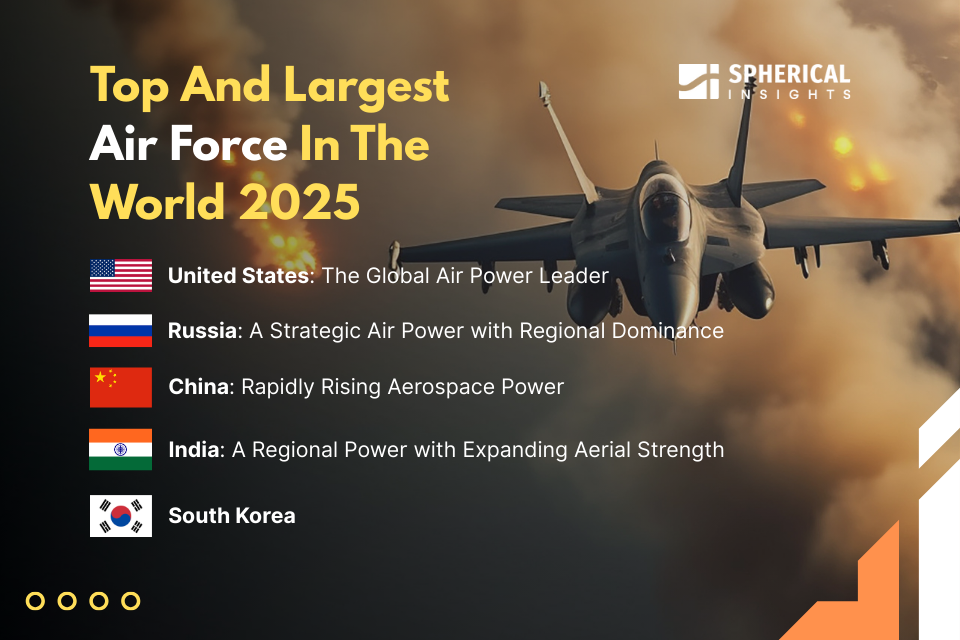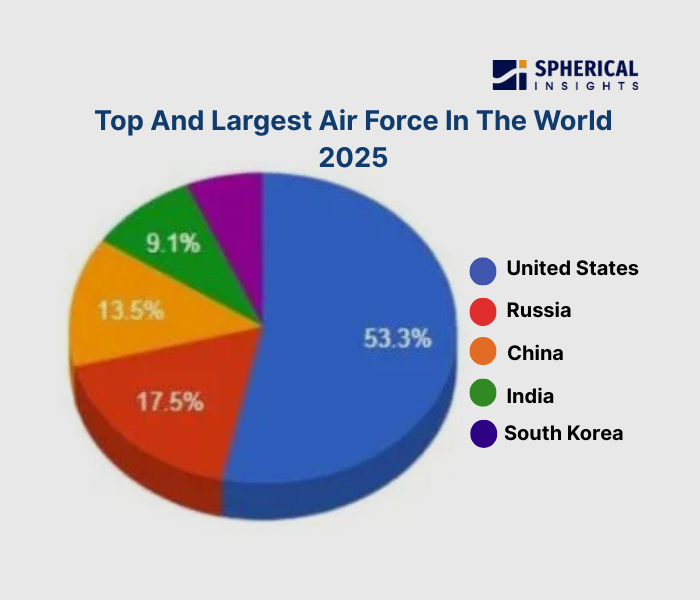
Top And Largest Air Force In The World 2025: Growth Analysis - By Spherical Insights
RELEASE DATE: May 2025 Author: Spherical InsightsRequest Free Sample Speak to Analyst
The capability of military aircraft is a crucial element of international defense strategies, serving as a foundation for rapid-response operations, force projection, and national security. Beyond defending their own borders, nations with the largest and most advanced military aircraft fleets by 2025 will significantly influence regional and international security dynamics. Fighter jets, bombers, transport aircraft, observation systems, aerial refuelers, drones, and early-warning aircraft are just a few of the many platforms that these air forces operate; each is designed to fulfill a specific strategic purpose.
Modernization Drives Global Air Force Expansion
Global military spending reached a record $2.44 trillion in 2023, signaling a significant shift in defense priorities, particularly in modernizing air power. This increase in spending underscores the strategic importance of maintaining air dominance in today’s rapidly evolving threat landscape. Countries worldwide are making substantial investments in advanced fighter jets, unmanned aerial systems (drones), and integrated air defense networks to enhance their aerial superiority. The size and capability of a nation's air force have become vital for both national security and international power projection, as modern combat dynamics increasingly rely on speed, precision, and technological superiority. Moreover, the largest and most advanced air forces are better equipped to safeguard their airspace and can also influence the outcome of conflicts that occur far beyond their borders.

The Air Supremacy Battle
The combined air power of South Korea, Japan, China, India, and Russia is less than that of the United States. It consists of 3,722 support aircraft, 1,854 fighters, and 5,737 helicopters. In actuality, the US spends more than $800 billion a year on military spending, which is about 40% of total military spending worldwide. With 1,554 helicopters, 809 fighters, and 610 support aircraft, Russia owns a third of the airspace of the United States, coming in a far second. In addition to having an aged fleet, Russia has lost more than 220 aircraft since the conflict in Ukraine began in 2022.
Although China is ranked third, the nation is making significant investments and developing technology quickly. The nation just a few weeks ago unveiled its new sixth-generation fighter jet, which combines the ability to carry out air-to-air or air-to-ground missions with stealth capabilities, a high cargo capacity, supersonic speeds, and increased range.
Top and largest air force in the world
1. United States - The Global Air Power Leader
The United States has the largest air force in the world, with a staggering fleet of 13,043 aircraft. The United States continues to make significant investments in its aerial capabilities, which solidifies its position as the leading military aviation power and accounts for around 40% of worldwide defense spending. A key component of American military power, the U.S. Air Force is outfitted with a wide variety of state-of-the-art fighter jets, strategic bombers, and sophisticated drones. The U.S. Air Force is essential to global force projection in addition to protecting national airspace, allowing the nation to conduct offensive and defensive operations anywhere in the world. The United States is firmly established as the standard for global air superiority due to its unparalleled reach, technological advantage, and combat preparedness.
2. Russia: A Strategic Air Power with Regional Dominance
Russia, which is ranked second in the world, has a strong air force of about 4,292 aircraft, which reflects its long-standing emphasis on strategic deterrence and aerial strength. A wide variety of contemporary fighter planes, long-range bombers, and strategic support aircraft, many of which are built for both conventional and nuclear missions, are flown by the Russian Air Force. In order to maintain its influence and oppose NATO's presence, Russia continues to place a high priority on maintaining a robust air defense posture, especially in Eastern Europe and Central Asia. The Russian Air Force, which is a major component of the nation's military policy, is essential to both national defense and power projection, helping to influence the course of regional and international conflicts.
3. China: Rapidly Rising Aerospace Power
China now possesses one of the fastest-growing air forces in the world, with a fleet of about 3,309 aircraft. The development of cutting-edge fighter planes, such the J-20 stealth aircraft, and an expanding fleet of unmanned aerial vehicles (UAVs) for combat and reconnaissance missions have been major priorities for the People's Liberation Army Air Force (PLAAF). China is establishing itself as a powerful global air power by means of relentless modernization and technological innovation. As the country increasingly looks to influence international security dynamics and counter Western presence in key geostrategic zones, its growing air capabilities are essential to establishing military dominance in the Asia-Pacific region and to expanding its worldwide defense footprint.
4. India: A Regional Power with Expanding Aerial Strength
India has one of the most powerful air forces in the world, with a fleet of about 2,229 aircraft, and it is vital to the security of the Indian Ocean region. By combining domestic platforms like the Tejas with cutting-edge fighter aircraft like the Rafale and Su-30MKI, the Indian Air Force (IAF) has advanced significantly over the last ten years. India has also made investments in improved strike and surveillance capabilities and fortified its air defense systems. India's air force, a major regional force, is renowned for its ability to respond quickly and conduct precise combat missions. India's air power is essential to its deterrent strategy and is becoming more and more significant in regional and international security dynamics due to its geopolitical conflicts with its neighbors, especially China and Pakistan.
5. South Korea
South Korea has one of the most technologically advanced and advanced air forces in the Asia-Pacific area, with a fleet of about 1,592 aircraft. Through continuous improvements and cooperative defense initiatives with allies, the Republic of Korea Air Force (ROKAF) continues to improve its aerial capabilities while flying a variety of contemporary fighter jets, such as the F-35A. South Korea's air force, which is largely focused on air defense and strategic deterrence, is essential to defending the Korean Peninsula. ROKAF acts as a frontline shield, guaranteeing quick response and preserving military readiness in the face of North Korea's ongoing security threats. Its powerful air fleet serves as a stabilizing influence in one of the most strategically significant and tense areas of the world in addition to being essential to national defense.
Browse Related Reports:
- Iran Fighter Jet Market Size, Share, and COVID-19 Impact Analysis, By Aircraft Type (Fixed-Wing, Rotorcraft), By Take-Off & Landing (Conventional Take-off and Landing, Short Take-off and Landing, Vertical Take-off and Landing), and Iran Fighter Jet Market Insights Forecasts 2023 – 2033.
-
Japan Defence Market Size, Share, and COVID-19 Impact Analysis, By Armed Forces (Army, Navy, Air Force), and By Type (Personnel Training & Protection, C4ISR and EW, Vehicles, Weapons and Ammunition), and Japan Defence Market Insights, Industry Trend, Forecasts to 2032.
-
Global Air Defense System Market Size, Share, and COVID-19 Impact Analysis By Component (Weapon System, Fire Control System, Command and Control System), By Type (Missile Defense System, Anti-Aircraft System, C-Ram System), By Platform (Land, Naval, Airborne), and By Region (North America, Europe, Asia-Pacific, Latin America, Middle East, and Africa), Analysis and Forecast 2024 - 2035.
-
United States Military Aviation Market Size, Share, and COVID-19 Impact Analysis, By Aircraft Type (Fixed-Wing Aircraft, Rotorcraft), and United States Military Aviation Market Insights, Industry Trend, Forecasts to 2033.
-
Global Special Mission Aircraft Market Size, Share, and COVID-19 Impact Analysis, By Platform (Military Aviation, Commercial Aviation, and Unmanned Aerial Vehicle); By Application (Command and Control, Combat Support, Intelligence, Surveillance, and Reconnaissance, Air-Rocket Launch, Transportation, Others); By Point of Sale (OEM, Aftermarket), and By Region (North America, Europe, Asia-Pacific, Latin America, Middle East, and Africa), Analysis and Forecast 2023 - 2033.
About the Spherical Insights & Consulting
Spherical Insights & Consulting is a market research and consulting firm which provides actionable market research study, quantitative forecasting and trends analysis provides forward-looking insight especially designed for decision makers and aids ROI.
Which is catering to different industry such as financial sectors, industrial sectors, government organizations, universities, non-profits and corporations. The company's mission is to work with businesses to achieve business objectives and maintain strategic improvements.
CONTACT US:
For More Information on Your Target Market, Please Contact Us Below:
Phone: +1 303 800 4326 (the U.S.)
Phone: +91 90289 24100 (APAC)
Email: inquiry@sphericalinsights.com, sales@sphericalinsights.com
Contact Us: https://www.sphericalinsights.com/contact-us
Need help to buy this report?